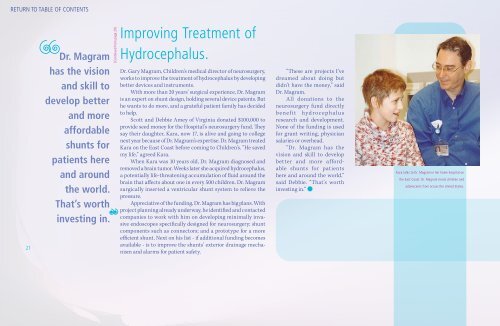Wellness, revolutionized. - Children's Hospital Central California
Wellness, revolutionized. - Children's Hospital Central California
Wellness, revolutionized. - Children's Hospital Central California
Create successful ePaper yourself
Turn your PDF publications into a flip-book with our unique Google optimized e-Paper software.
RETURN TO TABLE OF CONTENTS<br />
21<br />
Dr. Magram<br />
has the vision<br />
and skill to<br />
develop better<br />
and more<br />
affordable<br />
shunts for<br />
patients here<br />
and around<br />
the world.<br />
That’s worth<br />
investing in.<br />
(Continued from page 20)<br />
Improving Treatment of<br />
Hydrocephalus.<br />
Dr. Gary Magram, Children’s medical director of neurosurgery,<br />
works to improve the treatment of hydrocephalus by developing<br />
better devices and instruments.<br />
With more than 20 years’ surgical experience, Dr. Magram<br />
is an expert on shunt design, holding several device patents. But<br />
he wants to do more, and a grateful patient family has decided<br />
to help.<br />
Scott and Debbie Amey of Virginia donated $100,000 to<br />
provide seed money for the <strong>Hospital</strong>’s neurosurgery fund. They<br />
say their daughter, Kara, now 17, is alive and going to college<br />
next year because of Dr. Magram’s expertise. Dr. Magram treated<br />
Kara on the East Coast before coming to Children’s. “He saved<br />
my life,” agreed Kara.<br />
When Kara was 10 years old, Dr. Magram diagnosed and<br />
removed a brain tumor. Weeks later she acquired hydrocephalus,<br />
a potentially life-threatening accumulation of fluid around the<br />
brain that affects about one in every 500 children. Dr. Magram<br />
surgically inserted a ventricular shunt system to relieve the<br />
pressure.<br />
Appreciative of the funding, Dr. Magram has big plans. With<br />
project planning already underway, he identified and contacted<br />
companies to work with him on developing minimally invasive<br />
endoscopes specifically designed for neurosurgery; shunt<br />
components such as connectors; and a prototype for a more<br />
efficient shunt. Next on his list - if additional funding becomes<br />
available - is to improve the shunts’ exterior drainage mechanism<br />
and alarms for patient safety.<br />
“These are projects I’ve<br />
dreamed about doing but<br />
didn’t have the money,” said<br />
Dr. Magram.<br />
All donations to the<br />
neurosurgery fund directly<br />
benef it hyd rocepha lu s<br />
research and development.<br />
None of the funding is used<br />
for grant writing, physician<br />
salaries or overhead.<br />
“Dr. Magram has the<br />
vision and skill to develop<br />
better and more affordable<br />
shunts for patients<br />
here and around the world,”<br />
said Debbie. “That’s worth<br />
investing in.”<br />
Kara talks to Dr. Magram in her home hospital on<br />
the East Coast. Dr. Magram treats children and<br />
adolescents from across the United States.


